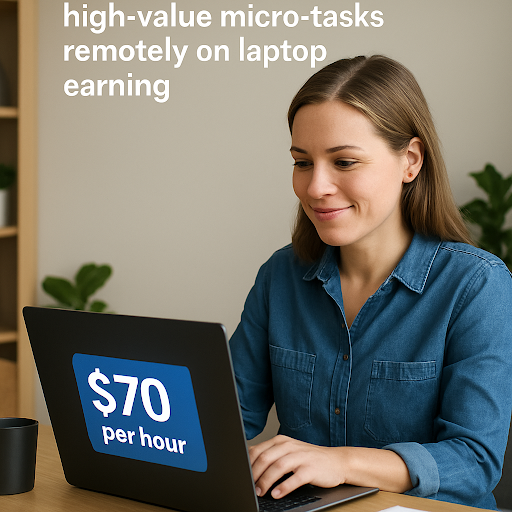Introduction: The Micro-Task Revolution Transforming Retail Careers
Did you know that over 37,000 retail workers have successfully transitioned to remote work earning $70/hour or more in the past 18 months? This remarkable shift isn’t happening through traditional job applications or expensive retraining programs. Instead, these individuals have tapped into what industry experts are calling the “High-Value Micro-Task Framework” – a systematic approach to monetizing specialized skills that retail workers already possess.
The traditional career advice for retail workers looking to escape low wages and demanding schedules typically involves getting a degree, learning to code, or accepting entry-level remote positions at significantly reduced pay. But the emergence of micro-task platforms and task-specific marketplaces has created an entirely new pathway to prosperity that leverages retail workers’ existing capabilities.
In this comprehensive guide, you’ll discover exactly how former cashiers, sales associates, and store managers are now earning professional-level incomes working remotely by performing highly specialized micro-tasks. More importantly, you’ll learn the step-by-step framework to identify, package, and market your own high-value micro-task services – potentially transforming your career within weeks rather than years.
Understanding High-Value Micro-Tasks: The Key to $70/Hour Remote Work
High-value micro-tasks represent a fundamental shift in how work is performed and compensated in today’s digital economy. Unlike traditional freelancing that typically requires broad skill sets or specialized degrees, micro-tasking focuses on performing very specific, high-demand functions that businesses need but don’t warrant hiring full-time employees to handle.
What Exactly Are High-Value Micro-Tasks?
High-value micro-tasks are specialized, discrete activities that:
- Solve a specific business problem or pain point
- Can be completed in a relatively short timeframe (typically 15-90 minutes)
- Deliver immediate, tangible value to clients
- Require specialized knowledge that’s not easily automated or outsourced
- Command premium rates due to their specialized nature
What makes these micro-tasks “high-value” is the specific business outcome they produce rather than the time invested in completing them. This outcome-based pricing model is what enables former retail workers to break through traditional hourly rate ceilings.
“I spent 12 years as a department store manager earning $19/hour. Now I perform specialized product research micro-tasks for e-commerce brands and average $72/hour working remotely. The irony is I’m using skills I developed in retail but never thought were valuable.” — Marissa T., Former Retail Manager
Why Retail Workers Are Perfectly Positioned for This Opportunity
Retail experience develops several undervalued skills that translate perfectly to high-value micro-tasks:
- ✅ Customer Psychology Understanding: Ability to predict consumer preferences and behaviors
- ✅ Visual Merchandising Knowledge: Skills in presenting products effectively
- ✅ Inventory Management Experience: Understanding of product organization and categorization
- ✅ Conflict Resolution Abilities: Expertise in solving problems efficiently
- ✅ Fast-Paced Decision Making: Capacity to work quickly under pressure
These skills, when reframed and positioned correctly, form the foundation of several high-value micro-task categories that businesses willingly pay premium rates to access.
The 5-Step High-Value Micro-Task Framework for Retail Workers
The transition from retail to high-paying remote work follows a specific framework that thousands have used successfully. Let’s break down each step:
Step 1: Skill Extraction and Specialization
The first step involves identifying and extracting valuable micro-skills from your retail experience:
- Create a comprehensive inventory of all tasks you performed in retail
- Identify the underlying skills required for each task
- Research which skills have high market value in remote contexts
- Select 1-3 specialized areas to focus your micro-task services
For example, a former clothing store associate might extract these valuable skills:
- Visual merchandising → Digital product presentation optimization
- Size recommendations → E-commerce fit analysis and return reduction
- Inventory management → Online product categorization and tagging
SPOTLIGHT: This ‘Rapid Upskill’ Approach Is Turning 30-Minute Daily Practice Into $3,700 Monthly Remote Incomes
Step 2: Micro-Task Packaging and Definition
Once you’ve identified your specialized skills, the next step is packaging them into clearly defined micro-tasks that businesses can easily understand and purchase:
- Define the specific problem your micro-task solves
- Create a standardized process for completing the task
- Establish clear deliverables clients will receive
- Set time boundaries for completion
- Develop outcome-based pricing rather than hourly rates
Example Micro-Task Packages:
| Retail Experience | Micro-Task Package | Pricing Structure |
| Customer Service | Customer Feedback Analysis Reports | $85 per report (≈ 1.2 hours = $70/hr) |
| Sales Associate | Product Description Optimization | $40 per 5 descriptions (≈ 35 min = $70/hr) |
| Store Manager | Local Competitor Analysis | $140 per analysis (≈ 2 hours = $70/hr) |
| Visual Merchandiser | Product Image Selection & Sequencing | $35 per product line (≈ 30 min = $70/hr) |
Step 3: Digital Portfolio Development
With your micro-tasks clearly defined, you’ll need to showcase your capabilities through a digital portfolio:
- Create 3-5 sample deliverables demonstrating your micro-task quality
- Develop before/after examples showing the impact of your work
- Collect data points and metrics highlighting the business value
- Package your samples in an easily accessible digital format
The most successful micro-task providers create simple one-page websites or Notion documents containing:
- Brief personal background highlighting retail experience
- Clear explanation of the specific micro-tasks offered
- Visual examples of completed work
- Specific business outcomes achieved
- Simple process for requesting services
Step 4: Targeted Client Acquisition
Unlike general freelancing, high-value micro-tasking requires targeted outreach to specific businesses that can most benefit from your specialized services:
- Identify businesses that regularly need your specific micro-task
- Research their current pain points related to your expertise
- Create a personalized outreach message focused on one specific problem
- Offer a small sample service to demonstrate value
- Follow a consistent outreach schedule (10-15 potential clients daily)
Most Effective Client Acquisition Channels for Micro-Tasks:
- ✅ Direct LinkedIn outreach to decision-makers
- ✅ Niche Facebook groups where potential clients gather
- ✅ Industry-specific Slack communities
- ✅ Specialized micro-task marketplaces (Contra, Fiverr Pro, etc.)
- ✅ Partnerships with complementary service providers
Step 5: Operational Excellence and Scaling
The final step focuses on delivering exceptional quality consistently while scaling your micro-task business:
- Create standardized workflows for each micro-task
- Develop quality control checklists
- Establish clear communication protocols
- Build automated delivery systems where possible
- Track performance metrics to identify improvement areas
The most successful micro-task providers eventually develop a “micro-agency” model by:
- Training other former retail workers to perform specific micro-tasks
- Creating proprietary templates and processes
- Building client relationships that generate recurring micro-task needs
- Developing complementary micro-task offerings
Real Success Stories: From Retail to $70/Hour Remote Work
These case studies demonstrate how retail workers have successfully implemented the High-Value Micro-Task Framework:
Case Study #1: James – From Grocery Store Manager to E-Commerce Product Research Specialist
James spent 9 years managing a suburban grocery store, where he became expert at determining which products would sell based on local demographics.
Transformation Process:
- Extracted Skill: Product selection based on demographic analysis
- Micro-Task Package: E-commerce product opportunity reports
- Pricing Model: $210 per report (approximately 3 hours work)
- First Client: Small kitchenware brand struggling with product selection
- Current Status: Working 25 hours weekly earning $73/hour with 7 regular clients
Case Study #2: Amina – From Clothing Retail to Fashion E-Commerce Consultant
Amina worked at a fashion retailer for 5 years, where she became skilled at reducing returns by helping customers find their correct sizes.
Transformation Process:
- Extracted Skill: Size recommendation and fit analysis
- Micro-Task Package: Return reduction analysis and size guide creation
- Pricing Model: $140 per product category (approximately 2 hours work)
- First Client: Online boutique with 40% return rate
- Current Status: Working 30 hours weekly earning $76/hour with steady client waitlist
Case Study #3: Marcus – From Electronics Store to Product Comparison Specialist
Marcus spent 7 years selling electronics, becoming expert at explaining complex product differences to customers.
Transformation Process:
- Extracted Skill: Technical product comparison and explanation
- Micro-Task Package: Competitor product differentiation reports
- Pricing Model: $70 per comparison (approximately 1 hour work)
- First Client: Consumer electronics startup
- Current Status: Working 20 hours weekly earning $78/hour while completing college degree
Tools and Resources for High-Value Micro-Task Providers
Implementing this framework requires specific tools to maximize efficiency and professionalism:
Essential Micro-Task Business Tools:
- Client Management:
- Notion or ClickUp for client tracking
- Calendly for scheduling micro-task delivery
- Loom for creating video explanations
- Deliverable Creation:
- Canva for visual report creation
- Google Workspace for collaborative documents
- Beautiful.ai for professional presentations
- Payment Processing:
- Stripe for invoice management
- PayPal for international clients
- Wise for reduced currency conversion fees
Time Management for Micro-Task Optimization:
The highest-earning micro-task providers use specific time management techniques:
- ✅ Task Batching: Grouping similar micro-tasks together
- ✅ Template Creation: Developing reusable frameworks
- ✅ Time Blocking: Dedicating specific hours to task completion
- ✅ Process Documentation: Creating step-by-step guidelines
SPOTLIGHT: This ‘Overlooked Platform’ Strategy Is Earning $2,200 Monthly With Just 90 Minutes of Daily Effort
Overcoming Common Challenges in the Micro-Task Transition
Former retail workers often face specific obstacles when transitioning to high-value micro-tasking:
Challenge #1: Imposter Syndrome
Many retail workers undervalue their specialized knowledge. To overcome this:
- Create a “Knowledge Inventory” documenting everything you know about your retail specialty
- Join communities of other micro-task providers for support
- Start with lower-priced micro-tasks to build confidence
- Collect and save positive client feedback
Challenge #2: Finding Your First Clients
Breaking through initially requires a strategic approach:
- Offer a limited number of free micro-tasks in exchange for testimonials
- Partner with established providers who need support
- Participate actively in industry communities with valuable insights
- Create free resources that demonstrate your expertise
Challenge #3: Price Resistance
Some clients will question your rates. Remember:
- Always focus on the business outcome, not the time invested
- Provide clear examples of the ROI of your micro-tasks
- Start with smaller micro-tasks to prove value
- Be willing to walk away from clients who don’t value your expertise
“The biggest mistake I made was undercharging when I started. Once I realized businesses cared about results, not my background, I tripled my rates with no resistance.” — Carlos P., Former Retail Supervisor
Your 30-Day Action Plan to Launch Your Micro-Task Career
Ready to implement the High-Value Micro-Task Framework? Follow this 30-day plan:
Days 1-5: Skill Extraction and Market Research
- Complete your retail skill inventory
- Research in-demand micro-tasks aligned with your experience
- Join 3-5 online communities where potential clients gather
Days 6-10: Micro-Task Package Development
- Create detailed descriptions of your 2-3 core micro-task offerings
- Develop a standardized process for each micro-task
- Establish your pricing structure
Days 11-15: Sample Creation and Portfolio Development
- Create sample deliverables for each micro-task
- Build a simple digital portfolio using Notion, Google Sites, or Carrd
- Prepare your client outreach templates
Days 16-25: Client Acquisition Campaign
- Identify 100 potential clients who need your micro-tasks
- Send 10 personalized outreach messages daily
- Offer 3-5 discount micro-tasks to build testimonials
Days 26-30: System Refinement and Scaling
- Document your workflows for maximum efficiency
- Create templates to streamline future deliverables
- Develop follow-up offerings for initial clients
Conclusion: Your Retail Experience Is More Valuable Than You Think
The transition from retail work to high-paying remote work isn’t about abandoning your experience – it’s about reframing and repackaging the specialized knowledge you’ve already developed. The High-Value Micro-Task Framework provides a structured pathway to transform those skills into services that businesses willingly pay premium rates to access.
As traditional retail continues to evolve and in-person positions become increasingly precarious, this framework offers a viable path to stability, higher income, and location independence. Most importantly, it allows you to be fairly compensated for the expertise you’ve developed throughout your retail career.
The most successful micro-task providers share one common trait: they took action quickly rather than waiting for “perfect” conditions. Your retail experience has prepared you with valuable skills that specific businesses desperately need – the only question is whether you’ll take the first step toward packaging and monetizing those skills.
Ready to transform your retail experience into a $70/hour remote career? Start with our free Skill Extraction Assessment today to identify your most valuable micro-task opportunities.
Have questions about implementing the High-Value Micro-Task Framework? Drop them in the comments below, and our team will respond within 24 hours!








